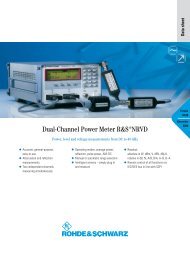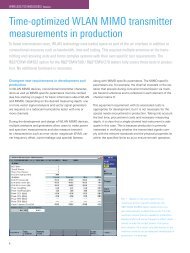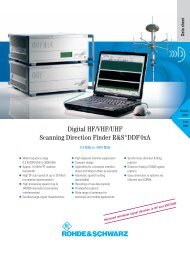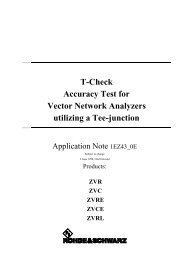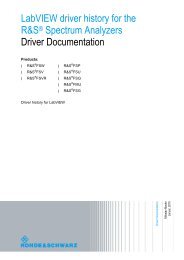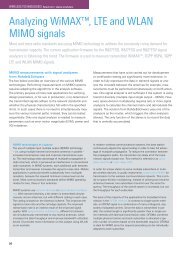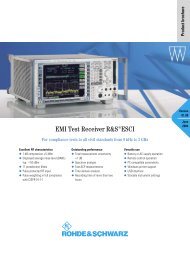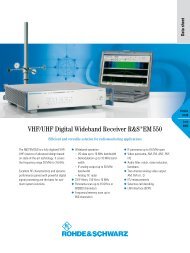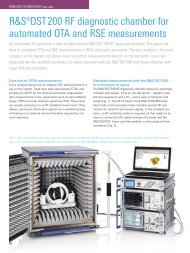English - Rohde & Schwarz
English - Rohde & Schwarz
English - Rohde & Schwarz
You also want an ePaper? Increase the reach of your titles
YUMPU automatically turns print PDFs into web optimized ePapers that Google loves.
This new option can supply a connected<br />
DUT with a voltage of +3.3 V or<br />
+5 V. The high levels of data and clock<br />
adjust automatically. A special feature<br />
of the digital output is that it outputs<br />
data and clock only for DUTs with<br />
the supply voltage applied. Otherwise<br />
all outputs are of high impedance to<br />
protect sensitive circuitry of the DUT.<br />
To avoid refl ection when operating<br />
AMIQ with clock frequencies >40 MHz,<br />
it is advisable to connect DUTs to the<br />
output using very short lines or to terminate<br />
them with the required impedance.<br />
A host of new applications<br />
The digital output allows a wide selection<br />
of applications. These range from<br />
measurements on DACs through tests<br />
of digital mobile-radio interfaces (see<br />
examples in boxes) to the use of lowvoltage<br />
differential signalling (LVDS)<br />
links. With the latter, high-frequency<br />
digital links (several hundred MHz)<br />
can be made on long lines using differential<br />
signals of low amplitude. For<br />
this purpose AMIQ-B3 drives an LVDS<br />
transmitter component that converts<br />
the signals into a serial data stream of<br />
higher frequency. A cable up to 10 m<br />
long connects the transmitter output<br />
with an LVDS receiver, which converts<br />
the data back into their original parallel<br />
format. In this way the digital signals<br />
from AMIQ-B3 can be routed over long<br />
distances or the associated LVDS chips<br />
can be tested.<br />
Through continuous product upgrading<br />
and especially thanks to the new<br />
AMIQ-B3 option, AMIQ once more<br />
emphasizes its role as a universal modulation<br />
generator meeting all requirements<br />
of the digital communication<br />
age.<br />
Burkhard Küfner;<br />
Dr Rene Desquiotz<br />
Example: testing DACs<br />
Digital/analog converters<br />
(DACs) link the<br />
digital to the analog<br />
world. High-resolution<br />
digital words at<br />
high sample frequency<br />
are needed<br />
to test new DAC<br />
designs. Its optional<br />
digital I/Q output<br />
makes AMIQ03/04<br />
ideal for this application<br />
due to word<br />
width of up to 16 bits<br />
per channel and a<br />
clock frequency up to<br />
100 MHz (FIG 3).<br />
CLK<br />
ext.<br />
Internal<br />
clock<br />
source<br />
REFERENCES<br />
[1] Kernchen, Wolfgang; Tiepermann, Klaus-<br />
Dieter: I/Q Modulation Generator AMIQ –<br />
Convenient generation of complex I/Q signals.<br />
News from <strong>Rohde</strong> & <strong>Schwarz</strong> (1998)<br />
No. 159, pp 10 –12<br />
[2] Küfner, Burkhard: I/Q Modulation Generator<br />
AMIQ – more applications through dif-<br />
Condensed data of AMIQ-B3<br />
Output 68-pin connector (submin D, half pitch)<br />
Number of channels 2 (one each for I and Q)<br />
Resolution selectable from 8 to 16 bits<br />
Output impedance approx. 50 Ω (typ.)<br />
DC voltage output selectable +3.3 V or +5 V<br />
Clock frequency max. 100 MHz (normal and inverted<br />
polarity)<br />
Reader service card 166/08<br />
int.<br />
I signal<br />
A critical aspect of<br />
these measurements<br />
is the spectral purity of the clock used. An<br />
impure clock signal causes a DAC to generate<br />
additional harmonics and nonharmonics,<br />
which in turn reduce the spurious-free<br />
dynamic range. To eliminate this source<br />
of error, the DUT can be supplied with a<br />
clock of extremely high spectral purity from<br />
an external source, eg a crystal oscillator<br />
or synthesizer, and the matching control<br />
signals obtained from the digital AMIQ<br />
output. AMIQ is driven by the same clock<br />
for the necessary synchronization of clock<br />
edges with the data from the option. For<br />
clock frequencies above approx. 40 MHz,<br />
CLK<br />
I signal<br />
Q signal<br />
Latch<br />
DAC<br />
DAC<br />
≤16<br />
CLK<br />
VCC<br />
Q signal Latch<br />
≤16<br />
AMIQ AMIQ-B3<br />
DUT<br />
Application notes<br />
Delay<br />
External<br />
clock<br />
source<br />
DAC<br />
DAC<br />
FIG 3 AMIQ with AMIQ-B3 option testing<br />
DACs<br />
the internal delay of AMIQ (max. approx.<br />
25 ns) has to be taken into account by<br />
delaying the clock accordingly.<br />
After loading of the desired trace into the<br />
AMIQ output memory by WinIQSIM (sinusoidal<br />
or multitone signal), a spectrum<br />
analyzer can be used to check the impact<br />
on spectral purity at the DUT output by<br />
varying bit width and clock frequency.<br />
ferential I/Q outputs. News from <strong>Rohde</strong> &<br />
<strong>Schwarz</strong> (1999) No. 162, pp 20 –21<br />
[3] Pauly, Andreas; Holzhammer, Jens: I/Q<br />
Simulation Software WinIQSIM – New<br />
approaches in calculating complex I/Q signals.<br />
News from <strong>Rohde</strong> & <strong>Schwarz</strong> (1998)<br />
No. 159, pp 13–15<br />
News from <strong>Rohde</strong> & <strong>Schwarz</strong> Number 166 (2000/I) 23




